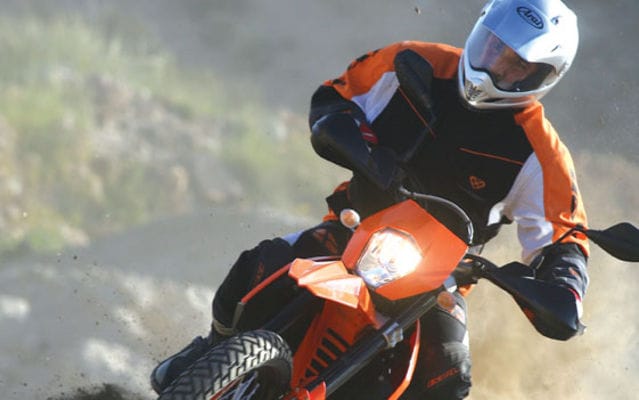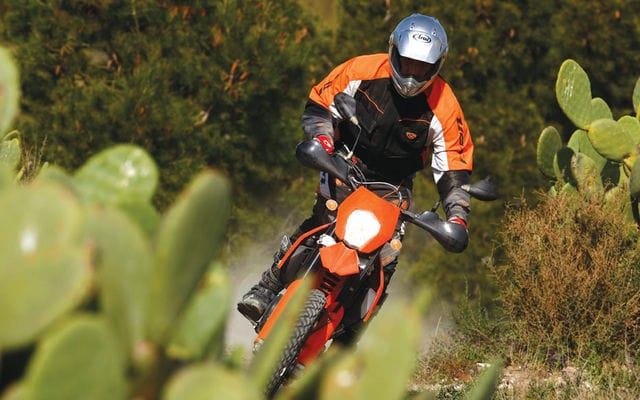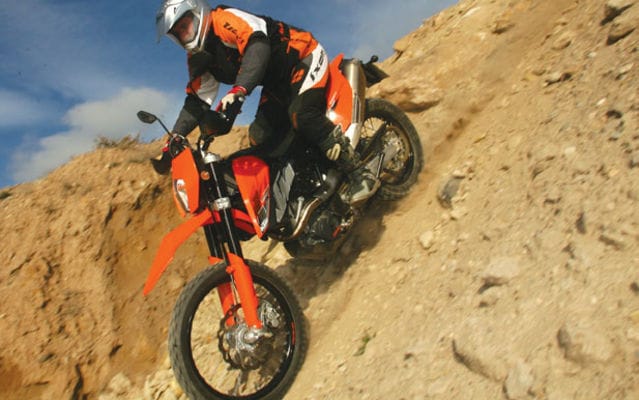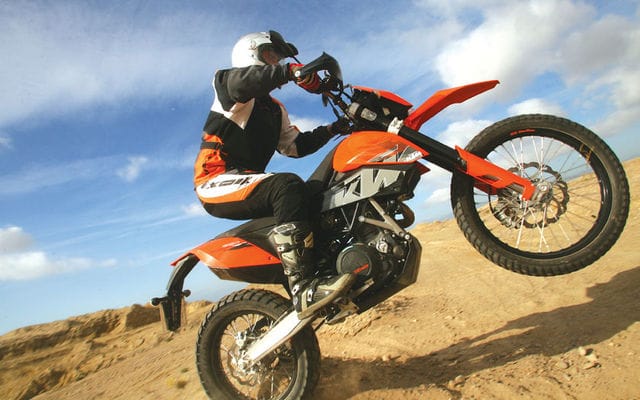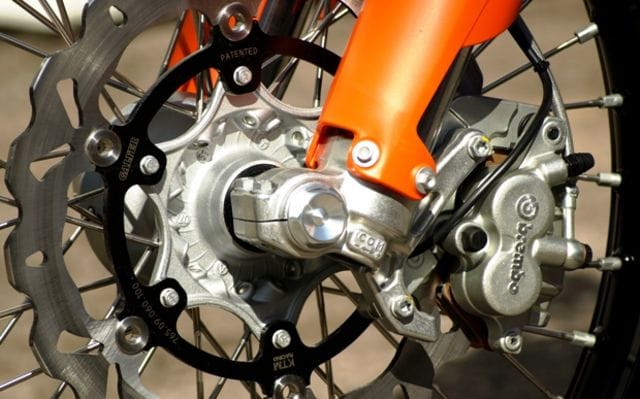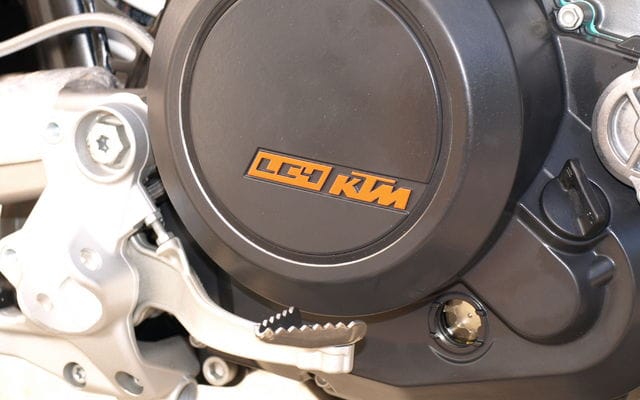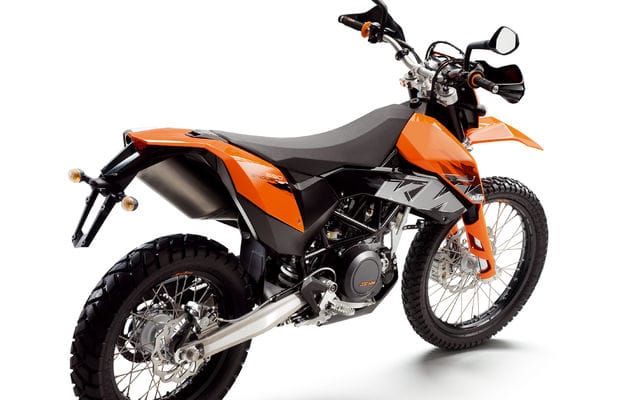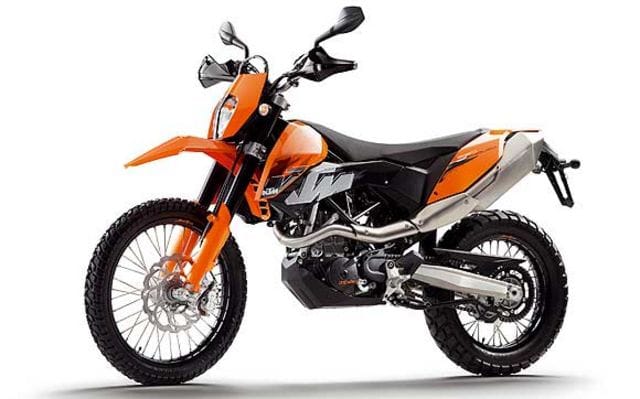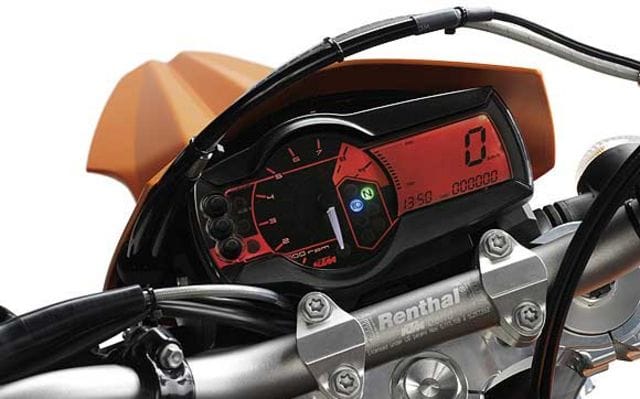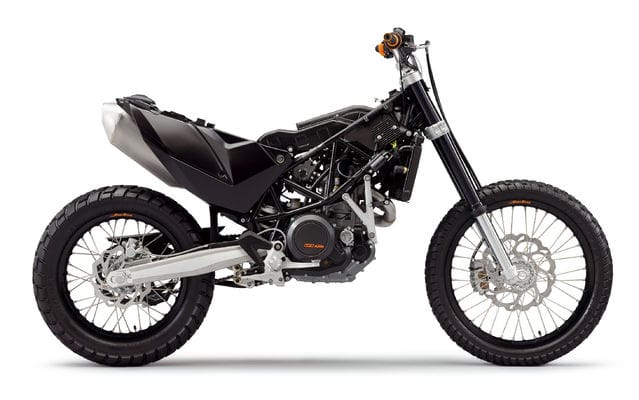CONVINCING DISPLAY
You know it’s going to be an exciting press test when the pre-ride briefing wraps up with this piece of sage advice: “It would be nice not to have to pick you up by helicopter at the bottom of a canyon.” We’re in southern Spain to ride the 690 Enduro dual-sport, and from what I gather, we’ll test it quite thoroughly.
The 690 Enduro replaces the 640 Adventure as KTM’s big-bore dual-purpose single; aside from the new, larger-displacement LC4 engine and complete redesign, the Enduro is stripped of the Adventure’s frame-mounted fairing and large–capacity fuel tank. The last time KTM offered a similar machine was in 2004 with the 640 Enduro.
Engine performance is improved with added displacement and fuel injection but the single biggest improvement over the old model is the addition of a counterbalancer, which proves its worth well beyond the added weight.
We begin the day with a 10-kilometre asphalt ride to the trailhead, which starts in a quarry. Although this ride is brief, I immediately notice the lack of engine vibration, the light, neutral steering and a powerful front brake. I’m initially concerned about the front brake’s performance on dirt, afraid it will need a feather touch to avoid lockup, but it later proves easy to modulate and is not overly sensitive.
Another concern is with the tires we’re riding on. The Metzeler Saharas used on these European-spec bikes have a rounded profile and a moderate tread pattern, proving quite competent on the street, but perhaps lacking adequate off-road traction. My concerns are quelled after we hit the dirt. These tires wouldn’t be my first choice for a serious day of trail riding, lacking the confidence-inspiring bite of knobbier tires, but they provide useable grip. In Canada, 690 Enduros will arrive with more aggressive Pirelli MT21 tires, which are better suited for off-road excursions, but will likely wear quicker on pavement.
After a brief photo session in the quarry, another journalist and I are led on a 50 kilometre loop by one of KTM’s test riders. The loop is traced mostly along dirt roads and two-track dirt paths with surfaces changing from hard packed to rocky to sandy. I experiment with the engine’s three different power curves (all 690s have this feature; the SMC and Enduro add a fourth for poor-quality fuel), though I must stop and remove the seat for access to the selector switch. As suggested by our guide, the 690 is least strenuous to ride in the softest power mode (maximum power is reduced to 48 hp from an unrestricted 63). Throttle modulation is smoother and the bike requires less concentration to ride, as it doesn’t unexpectedly kick up a rider-induced roost when hitting unseen bumps. The soft power mode is ideal for an intermediate rider developing his skills, though it demands added attention to gear selection and the bike requires a downshift when ascending steep hills.
I prefer the most aggressive power curve off-road; it provides more bottom-end power and allows you to carry a gear longer, requiring fewer gear changes from the smooth-shifting transmission. It does, however, require a steadfast throttle hand; it’s too easy to break the rear tire loose, especially when climbing.
On the street, I find the standard curve works best; power delivery isn’t as abrupt at lower speeds as with the aggressive curve so you can putter about town smoothly, yet all of the engine’s power is available for highway passing, and there’s plenty of it. Getting quickly by a car driving 110 km/h needs nothing more than a brief twist of the throttle.
After this short ride we return to the quarry to join a larger group of journalists wrapping up their photo sessions. I’m a little disappointed that our ride was devoid of trails rough enough to need helicopter backup. Then KTM product manager Joachim Sauer asks if anyone would like to join him on a 15 minute trail ride before heading back to the hotel.
There’s one thing I learned about KTM staff members during this press launch, my first hosted by the Austrian firm: they all ride and they ride hard. The morning loop we’d ridden was the “journalist” loop, meant for pussyfoots who might not know how to handle a bike too well off road. Sauer, a former European enduro champion and holder of nine ISDE medals (eight of which are Gold), as well as several KTM staffers would trail ride almost every day during this Spanish launch, after the journalists retired to the hotel, post-test, for an opulent meal and a cocktail. These KTMers rode a different loop. Eight of us line up behind Sauer, with former WEC champion and Dakar competitor Giovanni Sala closing up behind.
Five hundred metres along the gravel road we started on earlier in the day, Sauer, who is visibly sore from a hard crash the day before, turns right, into the brush and down a steep 20 metre long hill to join a barely visible single-track trail. This path snakes up and down hills and is criss-crossed with deep ruts formed by rainwater draining off the surrounding mountains.
I haven’t been on a dirt bike in about five months and my reflexes are a bit sluggish, but I’m stuck behind a timid rider who keeps slowing at the first sight of an obstacle. This causes me to check up constantly behind him, which breaks my momentum and ultimately tires me. It’s hard to make a pass on this narrow trail and I stop behind him, reach out with my foot for support and feel nothing. I lose balance and topple over unhurt, but it’s then that I discover the machine’s first flaw. The rear-mounted fuel tank making up the tail section of the bike doesn’t have grab handles, so I grasp it by the rear, at what would normally be a number plate, and lift the machine. The piece is solid, but it doesn’t provide a good grip or proper leverage for the task. It’s at this time that I also realize that the muffler becomes scalding hot. I don’t get burned, but I feel the heat through my gloves; another journalist melted his boot while adjusting power modes. I turn the ignition off and on again to reset the tip-over sensor that cut the engine and re-start the bike.
This is the first time I ride a bike equipped with a slipper clutch off-road and find it beneficial, but in an entirely different manner than on pavement. I feel its effect best on a long, steep downhill, descending smoothly using the linear engine braking it provides and a combination of front and rear brakes.
We gather at the bottom of the hill to prepare for a ridiculously steep ascent (for me, anyway). The cliff side is about two storeys high and the last two metres are nearly vertical. I watch as one by one those ahead of me get a short run on the hill, short-shift into second, climb the wall and clear the top, some just barely as their rear wheel spins on the edge, spraying roost below. I listen as Sala gives a few pointers to the rider ahead of me who was having difficulty in the trail and pick up just one piece of information I find imperative; in a thick Italian accent, he tells the rider: “Hold gas open—no stop, eh?” He doesn’t heed Sala’s advice and stalls just short of clearing the wall. Fortunately the riders up top are prepared and they grab the front wheel and pull him up. I’m afraid of doing the same so I leave the bike in first gear, gas it and stylishly jump the bike over the ridge (albeit unintentionally), landing flat on both wheels to applause in my head. Sala follows and looks like he’s just cleared a speed bump.
I take advantage of this stop to get ahead of the slower rider and continue at an increased pace. The trail is still a tight single track, winding about with very few flat sections. At this pace, about 60 km/h, the 690 Enduro hides its weight well and handles rough terrain effortlessly, sailing off jumps and skipping across deep ruts. Standing on the footpegs, the bike fits me well, though I’d try the handlebar in a more rearward position (clamps are four-way adjustable) for a more upright posture. Standing also gets me off the hard, narrow seat, which like on the 690 SMC is designed “for aggressive riding.”
With some momentum, the Enduro demands much less effort to ride and steers with precision around obstacles. WP suspension components soak bumps fluidly, are fully adjustable and are much more compliant than on the race-ready 530 EXC-R tested in the April issue. Our 15-minute ride takes 45 minutes, though I wish we’d gone on longer. Others in the group wish they were soaking in a hot bath with a martini. Our return to the hotel includes a quick blast along a slightly longer stretch of twisty asphalt than this morning’s run, and a short stint on the highway.
This ride confirms the 690 Enduro’s all-round purposefulness; finally, we’ve got a modern, big-bore dual-sport with equally high performance on and off the trails. Unlike the firm’s 530 EXC-R, the 690 Enduro will appeal to a much broader audience whose main concerns don’t include winning national hare scrambles. For riders with a more adventurous streak, KTM offers touring accessories including aluminum side cases, a tank bag and a larger 18-litre fuel tank.
I am now faced with a dilemma. I’ve been looking for one machine on which I can commute, take the occasional weekend tour, explore less-travelled dirt roads and use for serious trail riding. Aside from its terribly uninviting seat, the $9,798 Enduro does all those things very well—but the seat isn’t my problem, a gel replacement seat will likely hit the market soon anyway. I must now clear my garage of motorcycles made redundant by this new KTM. It’s time to post some classified ads.
DISHING THE DIRT
With the 690 Enduro, KTM holds the title of offering the highest-tech dual-sport single in Canada. BMW’s G650X Challenge is the only other bike in the category with fuel injection; KTM takes digital engine management a step further with fly-by-wire throttle control.
As on Yamaha’s 2006 R6, the first bike to feature fully electronic throttle control, the rider’s right hand controls a throttle position sensor, which along with other engine parameters feeds information into the electronic control unit (ECU), which then dictates throttle-valve opening based on a preset map. It is this electronic control that allows the incorporation of selectable power modes, accessed on the Enduro via a dial switch located beneath the seat. In case of a system failure, the throttle valve can still be closed manually through a cable-operated fail-safe mechanism.
Power is increased over the 640 model through a 1 mm larger bore and 2 mm larger stroke, which bumps displacement to 654 cc from 625. Maximum output has gone up significantly, the 690 pumping out 63 hp at 7,500 rpm compared to the 640’s 53 hp at 7,000 rpm. Peak torque is also up by 7 lb-ft, now at 47. Vibration is drastically reduced with the addition of a counterbalancer and a sixth gear is added. Its slipper clutch makes it the first dual-sport so equipped.
The Enduro shares its chassis with the 690 SMC, with a tubular-steel chrome-moly trellis frame, an unusual but effective choice for a dual-sport machine. Steering geometry is quicker than on the 640 Adventure, with rake at 27 degrees, trail at 115 mm and wheelbase at 1,450 mm/57.1 in. (27.5 degrees, 124 mm and 1,510 mm/59.5 in respectively for the Adventure). Also unusual is the rear-mounted 12-litre fuel tank, which also acts as the bike’s tailpiece. The airbox is mounted above the engine, where the fuel tank is usually located. Weight with fluids but without fuel is reduced considerably from the 640 Adventure’s claimed 149 kg (328 lb), to a more manageable 138.5 kg (305 lb).
Compared with the 690 SMC, the Enduro’s suspension travel is actually reduced by 25 mm at the front and 15 mm at the rear. This is to maintain a reasonable seat height despite the Enduro’s larger-diameter 21-inch front and 18-inch rear wheels. The lowered suspension adds just 10 mm to the seat height at 910 mm (35.8 in). Softer suspension settings than the SMC’s provide more sag when seated, effectively lowering the seat height. KTM uses a progressive-rate linkage type suspension for the first time on the 690 models, breaking from its traditional use of a linkage-less single shock design.
For obvious reasons, the SMC’s massive 320 mm front disc and radial-mount four-piston caliper are replaced on the Enduro with a 300 mm disc, squeezed by a dirt-friendly two-piston floating caliper. At the rear is the same 240 mm disc and single-piston caliper. Brembo brake calipers are used on both machines.
